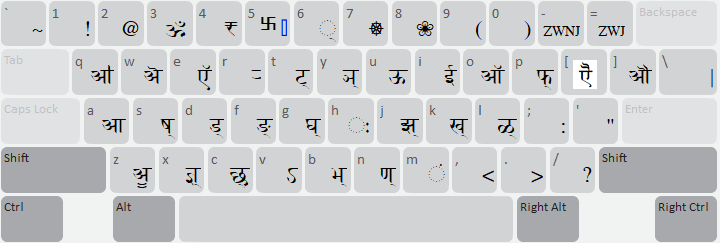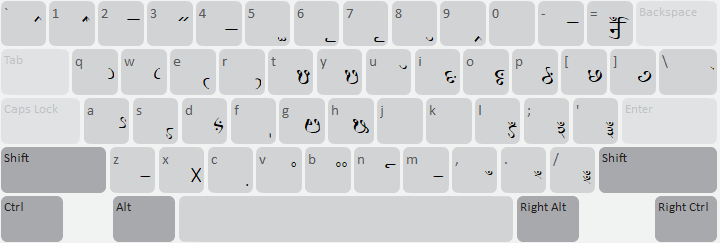Default (unshifted)

Shift

This Vedic Sanskrit Devanagari Keyman10 keyboard supports typing in (modified) ITRANS transliteration scheme. Currently Unshifted, Shifted, Right Alt and Right Ctrl layouts are used. You can install the keyboard for use with Keyman10 or above by downloading the itrans_devanagari_sanskrit_vedic.kmp file.
Vedic Sanskrit Devanagari (ITRANS) Keyboard packages for different o/s are available from https://keyman.com/keyboards/itrans_devanagari_sanskrit_vedic.
To use Vedic Sanskrit KeymanWeb, click in the text area below and choose the Sanskrit Vedic keyboard. You can test the keyboard online by typing in the text area.
This is a phonetic Devanagari keyboard layout with support for Vedic Sanskrit (Devanagari Extended and Vedic Extensions Unicode ranges). It is based on the ITRANS transliteration scheme by Avinash Chopde, with some minor modifications. You need to use a Unicode Devanagari font which has support for Vedic Sanskrit, e.g. Siddhanta font by Mihail Bayaryn.
You can phonetically type on the QWERTY keyboard using ITRANS trasliteration scheme and get Devanagari output. There are multiple options for getting certain Devanagari letters. Please note that some letters have been remapped based on user feedback compared to the initial version of the keyboard. Refer to the keyboard images and the tables in the help information below for the current mapping.
In addition toVedic Sanskrit, this keyboard can also be used for typing Hindi, Marathi and other languages written in Devanagari script. e.g. The keys saMskRRta will output the word संस्कृत, daRyA will output the Marathi word दर्या, laxmI or lakSmii or lakShmee will all output the same word लक्ष्मी, pahuMMchA will output the Hindi word पहुँचा .
In the default Sanskrit mode, `Panchama varna` ङ् and ञ् as part of consonant conjuncts can also be typed as n for convenience, e.g. mangaLa will output the word मङ्गळ, chanchala will output the word चञ्चल.
Here are some examples of text with commonly used Vedic accents.
Implicit `a` instead of explicit Virama for Hindi mode can be activated by pressing RCTRLRALT1 keys. In this mode, the implicit a is applied after the word ending consonant. e.g. kt space produces क्त and rAm, produces राम, instead of राम्, as output in the default Sanskrit mode. Press RCTRLRALT0 keys to reset the Hindi option.
The default and shifted layouts cover Devanagari digits, consonants, vowels and other commonly used characters.


The following table shows the English letters to type to get Devanagari consonants. e.g. type k for क्, ka for क, R for र् (eyelash Ra for Marathi), RR for ऋ, RR^ for ॠ, LL for ऌ, etc.
| क | ka | ख | Ka/kha | ग | ga | घ | Ga/gha | ङ | ~Na/Nga/Fa | ||||
| च | ca/cha | छ | Ca/Cha | ज | ja | झ | Ja/jha | ञ | ~na/Ya | ||||
| ट | Ta | ठ | Tha | ड | Da | ढ | Dha | ण | Na | ||||
| त | ta | थ | tha | द | da | ध | dha | न | na | ||||
| प | pa | फ | pha | ब | ba | भ | bha | म | ma | ||||
| य | ya | र | ra | ल | la | ळ | La | व | va/wa | ||||
| श | sha | ष | Sa/Sha | स | sa | ह | ha | क् | k | ||||
| श्र | shra | क्ष | xa/kSa | त्र | tra | ज्ञ | GYa/j~na/Xa | र् (eyelash Ra) | R |
In the following table, independent vowels, dependent vowel signs and vowel signs combined with the consonant 'k' are shown in ITRANS Sanskrit Vedic transliteration scheme on the top two rows. The third row shows Devanagari Vowels in their independent form on the left and their corresponding dependent form (maatraa or vowel sign) on the right. The fourth row shows the vowel sign combined with the consonant 'k' in Devanagari. 'ka' is without any added vowel sign, where the vowel 'a' is inherent.
If there is a need to type ONLY the vowel signs, it can be done using `@` instead of a consonant. e.g. @A will output ा, @ai will output ै.
| a | aa/A | i | ii/I/ee | u | uu/U/oo | RR | RR^ | LL | LL^ | e | ai/ei | o | au/ou | ||||||||||||||
|---|---|---|---|---|---|---|---|---|---|---|---|---|---|---|---|---|---|---|---|---|---|---|---|---|---|---|---|
| a | ka | aa | kA | i | ki | ii | kI | u | ku | uu | kU | RR | kRR | RR^ | kRR^ | LL | kLL | LL^ | kLL^ | e | ke | ai | kai | o | ko | au | kau |
| अ | आ | ा | इ | ि | ई | ी | उ | ु | ऊ | ू | ऋ | ृ | ॠ | ॄ | ऌ | ॢ | ॡ | ॣ | ए | े | ऐ | ै | ओ | ो | औ | ौ | |
| क | आ | का | इ | कि | ई | की | उ | कु | ऊ | कू | ऋ | कृ | ॠ | कॄ | ऌ | कॢ | ॡ | कॣ | ए | के | ऐ | कै | ओ | को | औ | कौ | |
The following table shows additional vowel signs used in Devanagari script by other languages.
| E/ae | O/aw | W | [ | ] | { | } | q | Q | z | Z | |
|---|---|---|---|---|---|---|---|---|---|---|---|
| kE/kae | kO/kaw | kW | k[ | k] | k{ | k} | kq | kQ | kz | kZ | |
| ऍ | ऑ | ऄ | ऎ | ऒ | ꣾ | ॵ | ॳ | ॴ | ॶ | ॷ | |
| ॅ | ॉ | ॆ | ॆ | ॊ | ꣾ | ॏ | ऺ | ऻ | ॖ | ॗ | |
| कॅ | कॉ | कॆ | कॆ | कॊ | कॊ | कꣾ | कॏ | कऺ | कऻ | कॖ | कॗ |
Arranged with the vowels are two consonantal diacritics, the final nasal anusvāra ं M and the final fricative visarga ः H (called अं aṃ and अः aḥ). Another diacritic used in other languages written in Devanagari script is the candrabindu/anunāsika ँ MM (अँ). These consonantal diacritics follow the vowel signs including the implicit `a`. The following table shows consonant `k` followed by various dependent vowel signs and consonantal diacritics ं and ः.
| ka | kA | ki | kI | ku | kU | kRR | kRR^ | kLL | kLL^ | ke | kai | ko | kau | |
|---|---|---|---|---|---|---|---|---|---|---|---|---|---|---|
| M | कं | कां | किं | कीं | कुं | कूं | कृं | कॄं | कॢं | कॣं | कें | कैं | कों | कौं |
| H | कः | काः | किः | कीः | कुः | कूः | कृः | कॄः | कॢः | कॣः | केः | कैः | कोः | कौः |
| MM | कँ | काँ | किँ | कीँ | कुँ | कूँ | कृँ | कॄँ | कॢँ | कॣँ | केँ | कैँ | कोँ | कौँ |
Consonant conjuncts are automatically formed, e.g. k t produces क्त्.
To force an explicit virama at end of word, use ^ e.g. k t ^ space produces क्त् .
A full (live) consonant with visible virama in middle of words can be typed using ^, e.g. k ^ S produces क्ष् .
To type a Zero Width Non Joiner, _ can be typed between the letters, for example: a _ i will generate अइ , k _ S will generate क्ष् .
To type a Zero Width Joiner, + can be typed between the letters, for example: k + S will generate क्ष् , while kS generates क्ष्.
| Key | Output Character | Comment |
|---|---|---|
| ,, | ॰ | Devanagari Abbreviation Sign |
| .. | । | DanDaa |
| ... | ॥ | Double DanDaa |
| -- | – | En Dash |
| --- | — | Em Dash |
| Key | Output Character | Comment |
|---|---|---|
| OM | ॐ | DEVANAGARI OM SIGN |
| # | ॐ | DEVANAGARI OM SIGN |
| $ | ₹ | RUPEE SIGN |
| % | ࿕ | U+0FD5 RIGHT-FACING SVASTI SIGN |
| * | ❀ | U+2740 WHITE FLORETTE UNICODE CHARACTER |
| & | ☸ | U+2638 WHEEL OF DHARMA UNICODE CHARACTER |
| V | ऽ | AVAGRAHA |
| Key | Output Character | Comment |
|---|---|---|
| '' | ॑ | DEVANAGARI STRESS SIGN UDATTA - SVARITA |
| ''' | ᳚ | VEDIC TONE DOUBLE SVARITA |
| '''' | ᳛ | VEDIC TONE TRIPLE SVARITA |
| `` | ॒ | DEVANAGARI STRESS SIGN ANUDATTA |
| MM^ | ꣳ | CANDRABINDU VIRAMA |
| == | ᳶ | VEDIC SIGN UPADHMANIYA |
| Key | Output Character | Comment |
|---|---|---|
| 8= | ꣢꣯ | e.g. ज꣢꣯ |
| 9= | ꣢꣫ | e.g. ल꣢꣫ |
| 0= | ꣣꣬ | e.g. क꣣꣬ |
| a= | ꣪ | Combining Devanagari Letter A |
| u= | ꣫ | Combining Devanagari Letter U |
| k= | ꣬ | Combining Devanagari Letter KA |
| n= | ꣭ | Combining Devanagari Letter NA |
| p= | ꣮ | Combining Devanagari Letter PA |
| r= | ꣯ | Combining Devanagari Letter RA |
| s= | ꣱ | Combining Devanagari Sign Avagraha |
| v= | ꣰ | Combining Devanagari Letter VI |
| z= | ᳸ | VEDIC TONE RING ABOVE |
| x= | ᳹ | VEDIC TONE DOUBLE RING ABOVE |
| c= | ᳒ | VEDIC TONE PRENKHA|
| ,= | ᳓ | VEDIC SIGN NIHSHVASA |
| .= | ᳑ | VEDIC TONE SHARA |
| /= | ᳐ | VEDIC TONE KARSHANA |
| ;= | ꣺ | CARET = vaidika trutikaa |
| [= | ꣹ | Devanagari GAP FILLER |
| ]= | ꣸ | PUSHPIKA - placeholder or “filler” |
| \= | ꣻ | Devanagari HEADSTROKE = shirorekhaa |
| '= | ꣼ | SIDDHAM = siddhirastu |

